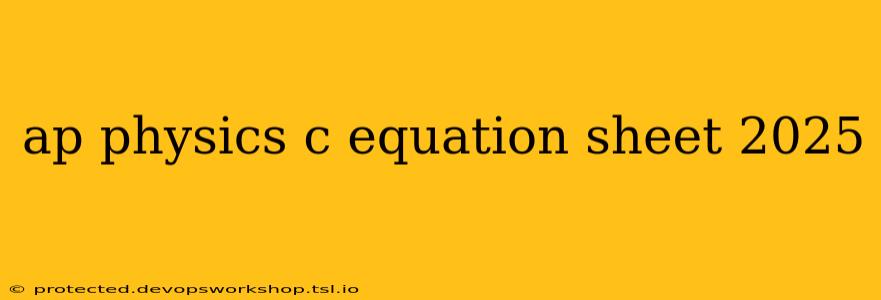The AP Physics C exam is a challenging but rewarding experience. Success hinges on a solid understanding of fundamental concepts and the ability to apply relevant equations efficiently. While memorizing every formula isn't necessary (the College Board provides an equation sheet), knowing which formulas to use and how to manipulate them is crucial. This guide provides a deep dive into the 2025 AP Physics C equation sheet, helping you navigate its intricacies and master its application. We'll break down key sections, offer practical tips, and provide examples to illuminate your understanding.
Understanding the AP Physics C Equation Sheet Structure
The official AP Physics C equation sheet is concisely organized, presenting formulas relevant to mechanics and electricity & magnetism. It's not a comprehensive list of every possible equation, but rather a collection of fundamental relationships. This encourages conceptual understanding rather than rote memorization.
The structure usually includes sections categorized by topic, such as:
- Kinematics: Equations governing motion, velocity, and acceleration.
- Dynamics: Formulas related to forces, Newton's laws, momentum, and energy.
- Circular Motion and Rotation: Equations dealing with angular velocity, angular acceleration, torque, and moment of inertia.
- Gravitation: Formulas related to Newton's Law of Universal Gravitation and orbital mechanics.
- Oscillations: Equations describing simple harmonic motion (SHM).
- Electrostatics: Formulas dealing with electric charge, electric fields, and electric potential.
- Electric Circuits: Equations related to current, voltage, resistance, and capacitance.
- Magnetism: Formulas describing magnetic fields, magnetic forces, and electromagnetic induction.
Key Formula Groups and Their Applications (Mechanics)
Let's explore some crucial formula groups within the mechanics section:
Kinematics
- Displacement: Δx = xf - xi (Simple, yet fundamental!)
- Average Velocity: vavg = Δx/Δt
- Instantaneous Velocity: v = dx/dt (Derivative of displacement with respect to time)
- Constant Acceleration Equations: These are vital, allowing you to relate displacement, velocity, acceleration, and time in various scenarios (e.g., vf = vi + at, Δx = vit + ½at², vf² = vi² + 2aΔx).
Practical Tip: Understand the limitations of these equations. They apply only to constant acceleration.
Dynamics
- Newton's Second Law: ΣF = ma (The cornerstone of classical mechanics)
- Work-Energy Theorem: Wnet = ΔKE (Relates work done to the change in kinetic energy)
- Conservation of Mechanical Energy: ΔEmech = 0 (In the absence of non-conservative forces)
- Momentum: p = mv and Impulse-Momentum Theorem: Δp = FΔt
Circular Motion
- Centripetal Acceleration: ac = v²/r = ω²r (Essential for understanding circular motion)
- Torque: τ = rFsinθ (The rotational equivalent of force)
- Angular Momentum: L = Iω (The rotational equivalent of linear momentum)
Key Formula Groups and Their Applications (Electricity and Magnetism)
The electricity and magnetism section requires a thorough grasp of fundamental concepts and their mathematical representation.
Electrostatics
- Coulomb's Law: Fe = k|q1q2|/r² (Describes the force between point charges)
- Electric Field: E = Fe/q (Force per unit charge)
- Electric Potential: V = kq/r (Potential energy per unit charge)
Electric Circuits
- Ohm's Law: V = IR (Relates voltage, current, and resistance)
- Power: P = IV = I²R = V²/R (Describes the rate of energy dissipation)
- Capacitance: C = Q/V (Relates charge stored to voltage across a capacitor)
Magnetism
- Magnetic Force on a Moving Charge: FB = qvBsinθ (Force on a charge moving in a magnetic field)
- Magnetic Force on a Current-Carrying Wire: FB = ILBsinθ (Force on a current-carrying wire in a magnetic field)
Mastering the AP Physics C Equation Sheet: Strategies for Success
- Don't just memorize; understand: Focus on the underlying physics principles behind each equation. Knowing why an equation works is far more valuable than simply memorizing it.
- Practice, practice, practice: Work through numerous problems, applying the equations in diverse contexts.
- Identify key relationships: Look for connections between different formulas. This helps in problem-solving flexibility.
- Use the equation sheet strategically: Don't rely on it blindly. Understand the context and choose the appropriate equations.
- Develop problem-solving skills: Learn to break down complex problems into smaller, manageable parts.
The 2025 AP Physics C equation sheet is a powerful tool. By understanding its structure, mastering its formulas, and honing your problem-solving skills, you'll be well-equipped to tackle the exam with confidence. Remember, the key is not just knowing the equations, but understanding how and when to apply them. Good luck!

